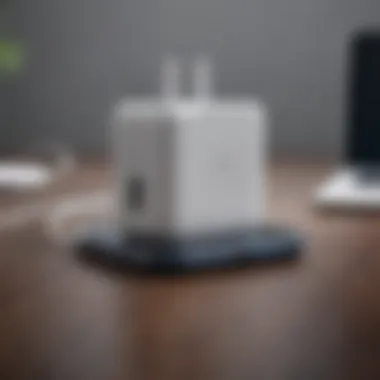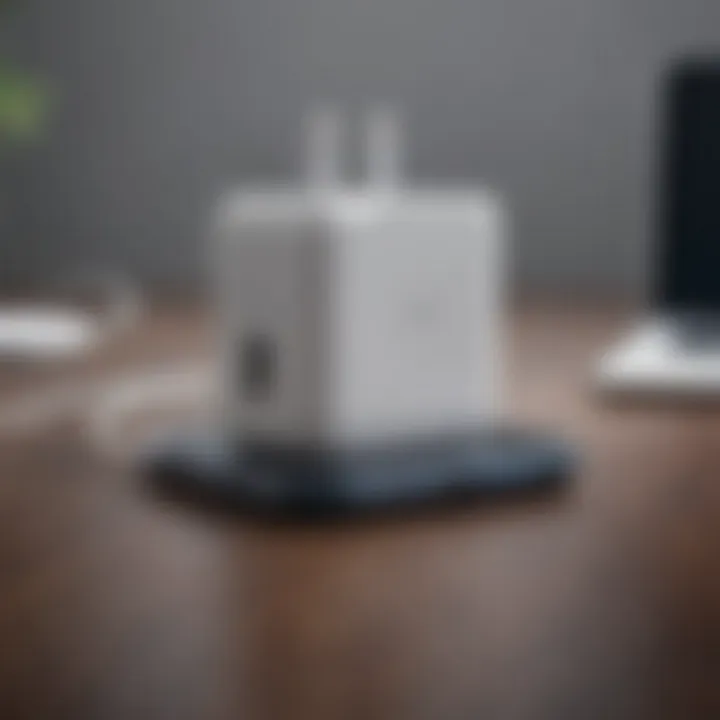Exploring iPhone 11 Chargers Available on Amazon


Product Overview
When it comes to charging devices, especially for an Apple product like the iPhone 11, understanding the options available is essential. The iPhone 11, known for its robust performance and sleek design, is compatible with a variety of chargers on Amazon. Choosing the right one isn’t just about connectivity; it's about optimizing performance, ensuring safety, and getting value for your investment.
Key Features and Specifications
One of the standout features of the iPhone 11 is its compatibility with both the standard 5W charger and faster alternatives that support wireless charging and USB-C power delivery. Some key specifications to consider include:
- Wattage: The iPhone 11 can handle up to 18W for fast charging, meaning you could potentially reach 50% battery in about 30 minutes when using a suitable fast charger.
- Charging Options: The device supports both wired and wireless charging, offering versatility for users on the go.
- Safety Features: With features such as temperature control and overcharging protection, Apple makes a point of ensuring that charging doesn’t damage the device.
Design and Aesthetics
The design of iPhone chargers ranges from the elegant simplicity of Apple's original charging adapters to more rugged, utilitarian designs found in third-party options. Apple chargers typically have a minimalist white finish, while many third-party chargers come in various colors and designs, catering to individual tastes.
Performance and User Experience
When looking into performance, it’s not just the specifications that matter; it’s how these chargers translate into everyday usability.
Performance Benchmarks
Chargers vary significantly in performance. An 18W charger tends to charge much faster than the standard 5W charger, while testers often find that reliable third-party chargers such as Anker or RAVPower give Apple’s offerings a run for their money in both speed and longevity.
User Interface and Software Capabilities
While chargers themselves don’t have interfaces per se, the benefit comes with how they interact with the iPhone 11’s responsive battery management system. Fast chargers can be particularly beneficial in busy settings, allowing for quick top-ups.
User Experiences and Feedback
Feedback from users varies. Many opt for Apple’s original chargers for peace of mind regarding safety and compatibility. However, numerous reviews point to third-party options being equal or better in performance at lower prices. It’s worth checking customer reviews to gauge reliability.
"The right charger makes a world of difference in daily convenience and device longevity."
Comparison with Previous Models or Competitors
Advancements and Improvements from Previous Models
One noticeable improvement in the iPhone 11 charging ecosystem compared to its predecessors is the increased support for fast charging technology. Prior models, like the iPhone XR, didn’t maximize the potential of faster networks, but Apple has clearly focused on improving this.
Competitive Analysis with Other Similar Products
In the market, there are numerous competitors to Apple’s offerings. Brands like Aukey and Belkin have created reliable chargers with various capabilities to enhance the charging experience. When navigating choices, scrutinize aspects like adapter wattage and cable quality.
Value Proposition
Understanding the value each charger adds is crucial. Investing in a reputable third-party charger can mean saving some cash, yet it might not always equate to the best charging experience. Weighing the pros and cons surrounding price versus performance is essential in making an informed decision.
Tips and Tricks
To get the most out of your charging experience with the iPhone 11, here are a few tips:
- Use Fast Chargers: Leveraging 18W chargers can significantly reduce charging time, saving you from the wait.
- Check Cable Quality: A sturdy, well-made cable is a linchpin in successfully merging power and device.
- Keep the Ports Clean: Regular cleaning of the charging port can prevent connectivity issues, enhancing performance.
Hidden Features and Functionalities
Play around with your phone's settings as well. You can activate "Optimized Battery Charging" in your settings, which extends battery health by learning your charging habits.
Troubleshooting Common Issues
Should you encounter issues such as slow charging, first ensure your cable and adapter are functioning correctly, as wear can cause speed reductions.
Latest Updates and News
Following industry trends is beneficial for staying updated with advancements in charging technology.
Recent Developments in Software Updates
Apple continually enhances iOS to ensure better battery management and charging speed, factors which are crucial for users wanting optimal performance from their devices.
Industry News and Rumors
Word on the street suggests that upcoming developments may include further advancements in fast charging or an even more seamless wireless charging experience, reflecting customer demands and technological innovation.
Events and Announcements from Apple
Keeping an eye on events like WWDC for potential charger updates or new product announcements can also provide further insight into Apple’s charging landscape.


With the variety of charging solutions available on Amazon, understanding your options and making informed choices will not only enhance your iPhone 11 experience but also extend the longevity of your device.
Intro to iPhone Chargers
In the age of smartphones, where our reliance on technology is non-negotiable, understanding chargers for our devices becomes paramount. The iPhone 11, with its blend of advanced features and user-centric design, deserves chargers that not only complement it but also enhance its performance. This article's aim is to shed light on the different charging options available on Amazon, from original Apple products to third-party alternatives. With so many choices, knowing what you need can significantly streamline the purchasing process.
Understanding Charging Needs
The charging needs of an iPhone 11 can vary greatly from person to person. Many consider how often they use their phone, where they primarily charge it, and the time they typically spend away from the charger. For those on the go, fast charging capabilities might be a game-changer, offering a quick top-up on busy days. Conversely, for users who primarily charge overnight, standard charging could suffice without the added concern of battery health.
- Usage Patterns:
- Some users might charge their phones multiple times during the day if they heavily utilize applications.
- Others might find that overnight charging or just once or twice a day suffices.
Each of these needs drives different preferences in chargers, whether it's wanting to pack a lightweight cable for travel or securing a powerful adapter for rapid replenishment at home or work.
Importance of Quality Chargers
When it comes to charging your valuable device, opting for quality cannot be overstated. Many benefit from understanding that the charger is a vital component in maintaining the longevity of their devices. Using subpar options can not only lead to slower charging speeds but also a decline in battery health. A quality charger not only delivers consistent performance but also typically integrates safety features to protect against overcharging or overheating.
"Investing in a reliable charger means you're investing in the longevity of your device—the iPhone 11 is an investment worth protecting."
Here are some points to consider regarding the quality of chargers:
- Safety: Quality chargers come equipped with protections against overcurrent and overheating, contributing to safe usage.
- Performance: A charger that adheres to Apple’s specifications ensures compatibility and efficiency, reducing the risk of device malfunction.
Types of iPhone Chargers Available on Amazon
Understanding the various types of chargers available for the iPhone 11 is essential for consumers who want to ensure they are making informed decisions before purchasing. On Amazon, the choices can be overwhelming due to the array of brands and specifications. By exploring these options, users can identify chargers that meet their needs without the anxiety of navigating through subpar products. This segment aims to illuminate the advantages and drawbacks of both original Apple chargers and reliable third-party alternatives, arming buyers with the necessary knowledge.
Original Apple Chargers
Original Apple chargers are tailored specifically for the iPhone 11, ensuring optimal performance and compatibility. These chargers not only provide a reliable power source but also come with assurances of quality and safety.
Lightning Cable Specifications
The Lightning cable is a core element of Apple's charging ecosystem, boasting features designed for efficiency. Key specifications include a reversible design, which allows the cable to be plugged in any way. This small detail saves users from the usual fumbling with other connectors. Moreover, Lightning cables support fast charging, allowing users to harness quicker power fills, which is especially vital on busy days. This versatility makes the Lightning cable a popular choice not just for iPhone 11 users, but for a broad range of Apple devices.
However, while Lightning cables are robust, they do come with their own challenges. Users often report issues with fraying or damage at the connector points, particularly if handled roughly. Despite the potential durability issues, owning an original Lightning cable can provide peace of mind as it is uniquely designed to work seamlessly with iPhones, which makes it a wise investment.
Power Adapter Variants
When it comes to power adapters, Apple offers a variety of options ranging from the standard 5W charger to the more robust 20W USB-C adapter. This assortment allows users to select chargers tailored to their specific charging habits.
The 20W adapter is particularly noteworthy as it supports fast charging capabilities, enabling the iPhone 11 to reach around 50% battery life in about 30 minutes. This feature is invaluable for users who prioritize quick power-ups during short breaks. However, this fast charging option does come at a premium price compared to the standard 5W charger.
Nevertheless, the flexibility in power adapter options allows consumers to choose a balance between cost and efficiency that suits their lifestyle.
Third-Party Chargers
Third-party chargers have gained popularity among iPhone 11 users due to their often lower price points and varied features. However, it’s imperative for consumers to select wisely to avoid any potential pitfalls associated with off-brand products.
Certified Brands
When considering third-party options, certified brands like Anker and Belkin emerge as reliable choices. Their products are typically MFi-certified, meaning they’ve met Apple’s compatibility standards, which can lead to improved performance and safety. This certification often reflects a commitment to quality, ensuring that the chargers won't cause any damage to the devices over time.
Such certified chargers can come with advantages like longer cables, additional ports, or extra features such as LED indicators to show charging status. Furthermore, users frequently find that these brands strike a balance between affordability and function, making them an attractive option amid the sea of choices available.
Potential Drawbacks
Yet, not all third-party chargers are created equal; users need to be wary of potential drawbacks. One significant risk lies in the use of cheaper materials that can compromise durability and safety. Some chargers may lack necessary safety features like overcurrent protection, which can lead to overheating or battery damage.
Additionally, consumers may encounter inconsistencies in performance, as non-certified products sometimes fail to deliver the power levels advertised, leading to frustrating slow charging experiences. This inconsistency can deter tech-savvy consumers who often seek reliability and efficiency from their charging solutions.
The key takeaway is while third-party options can offer value, they require thorough research and caution to mitigate possible risks.
Key Features to Consider
When scouring through Amazon for the perfect iPhone 11 charger, understanding the key features is vital. After all, it’s not just about slapping down some cash and taking home a charger. It’s about making a wise investment that caters to your daily needs. Key features like charging speed, cable length, and material quality can pave the way for a hassle-free experience. Let’s take a closer look at these must-consider factors.
Charging Speed
Standard vs. Fast Charging
Charging speed plays a crucial role in how quickly your iPhone 11 can go from low battery to fully charged. Standard charging, typically ranging from 5W to 12W, tends to be more traditional but is slowly becoming a fading star in the fast-paced world of technology. Conversely, fast charging boasts power outputs of 18W and beyond. This feature has made waves in the tech world, especially for those who are always on the go. The key here is efficiency – a fast charger can fill up your battery in less time than it takes to sip your morning coffee.
A unique aspect worth mentioning is that while fast charging is a favorite among many users, it can also lead to a bit of heat. Prolonged exposure to heat can negatively affect your battery. This, in turn, raises the elephant in the room: your long-term battery health. While fast charging can be a game changer for immediate needs, users should weigh the pros and cons.


Impact on Battery Health
Now, let’s dig deeper into the impact on battery health. It’s a hot topic nowadays, especially since users want their devices to go the distance. Fast charging can be a double-edged sword; while it provides convenience, it often raises concerns about degradation due to heat and high current rates. In essence, charging your device at a quicker rate can produce more heat, which, over time, could lead to reduced battery longevity.
It’s crucial to remember that while occasional use of fast charging is generally okay, relying on it consistently might not be the wisest choice. Many enthusiastic users find that switching between fast and standard charging can benefit overall battery performance. Think of it as a balance – a bit of quick energy when you need it, but also giving your battery some breathing room when things are more relaxed.
Cable Length and Durability
Choosing the Right Length
When it comes to charging cables, choosing the right length can significantly influence your charging experience. Picture this: a long cable gives you more freedom of movement, allowing you to comfortably use your phone while it charges, whether you're on your couch or at your desk. However, a longer cable can sometimes mean extra tangles and the potential for wear and tear.
On the flip side, a short cable might limit your flexibility but could be a lifesaver in terms of portability. For instance, if you often charge your phone in the car, a shorter cord could be easier to manage and won't take up much space in your bag. Knowing when and where you plan to charge your device will greatly influence your choice on cable lengths.
Material Quality Considerations
Lastly, material quality considerations cannot be overlooked. The buildings of the cable can determine its lifespan and efficiency. Premium materials like braided nylon often last longer than your standard plastic-coated cables. While they might cost a few bucks more upfront, they tend to save you money in the long run by not needing constant replacements.
On the other hand, cheaper cables might catch the eye with their price tag but can often lead to failures, frayed ends, or complete charging ineffectiveness. A solid option for those seeking quality should hence consider what’s beneath the surface, looking at reviews and specifications before committing to a purchase.
"Opting for a well-made charging cable can mean the difference in utilizing your iPhone 11 as intended—or finding yourself in a cycle of replacements."
How to Choose the Right iPhone Charger
Choosing the ideal charger for your iPhone 11 is a decision that can impact your device's longevity and efficiency. With the myriad options available on Amazon, making an informed choice is crucial. Not only does this guide cover compatibility, but it also emphasizes the significance of good customer reviews, which can lead you to products that meet your expectations or provide essential insights into their performance and durability. As the saying goes, "a stitch in time saves nine"; selecting the right charger now can save you from future headaches such as slow charging or, worse, device damage.
Assessing Compatibility
Compatibility is one of the first things to consider when selecting a charger for your iPhone 11. Apple has specific standards regarding charging protocols and connectors, primarily using the Lightning connector. While many third-party chargers claim compatibility, some may not deliver the same performance or safety features as the original products.
A few key aspects to look at:
- Connector Type: Ensure the charger has a Lightning connector, as other types will not fit your device.
- Power Output: iPhone 11 supports fast charging; thus, it's beneficial to select a charger that offers at least 18W output for optimal charging speeds.
- Certification: Look for MFi (Made for iPhone) certification on third-party chargers. This certification guarantees that the accessory meets Apple’s performance standards, minimizing risks of damage to your device.
Being diligent about compatibility not only elevates your charging experience but also safeguards your device from potential issues.
Reading Customer Reviews
Customer reviews are gold mines of information, shedding light on real-world performance and user satisfaction related to various chargers. They help paint a fuller picture of what you can expect beyond the product description.
Identifying Trends
When sifting through reviews, spotting common trends can significantly guide your decision-making. For instance, if multiple users mention that a specific charger consistently overheats or fails to charge the device properly, it’s a red flag. The benefit of identifying these trends lies in making proactive decisions—better to learn from someone else’s trouble than find yourself in the same boat.
The key characteristic of identifying trends is being able to discern between genuine issues and isolated incidents. This approach can prevent you from falling head over heels for an option that may not stand the test of time. Users often put emphasis on features that may seem minor at first glance, like cable flexibility or weight, which can affect portability and usability in daily life.
Evaluating Feedback
Evaluating feedback takes the review reading a step further—here, you dive into the specifics of what people are saying. An important aspect is looking for detailed reviews that explain both positive and negative experiences.
What makes evaluating feedback a popular choice is its ability to provide nuanced insights. For example, a review might detail that while a charger works great initially, it showed degradation over time, leading to slower charging speeds. This can be a decisive factor for those looking for longevity in their purchase.
In the bustling world of tech gadgets, feedback often comprises unique features that stand out. Perhaps a charger has an exceptional build quality or comes with additional safety features that set it apart. Weighing these nuances can tip the scale towards making a well-rounded choice.
"Always remember, an informed shopper is a smart shopper. Take the time to read up, and you’ll find the charger that fits your iPhone 11 like a glove."
Pricing Trends on Amazon
When navigating the bustling marketplace of Amazon for iPhone 11 chargers, pricing trends emerge as a notable focal point. The costs associated with these chargers not only reflect their quality but also play a crucial role in shaping consumer decisions. In this section, we will explore average price ranges and undertake a comparative analysis of brands, helping readers decipher how to make the most informed purchases.
Average Price Ranges
On Amazon, the price for iPhone 11 chargers can vary significantly, influenced by a number of factors, including brand reputation, charging capabilities, and included accessories. Here’s what you might typically expect:
- Apple Original Chargers: Generally priced higher, often ranging from $19 to $50, reflecting their branded quality and reliability.
- Third-Party Chargers: These can be more budget-friendly, with prices ranging from $10 to $30, depending on the brand and features.
- Accessories and Bundles: Many sellers offer combo deals, such as cables and power banks, which might cost anywhere from $15 to $40, providing additional value.
Understanding these average ranges helps users gauge what they should be paying and what they can expect. It’s a balancing act of budget versus quality that every buyer needs to approach carefully.
Comparative Analysis of Brands
When diving deeper into the charger market on Amazon, it’s essential to pit the brands against each other. Not all chargers are created equal, and discerning the nuances in performance and reliability can make all the difference.
- Apple: As the creator of the iPhone 11, Apple chargers are often seen as the gold standard. Their performance is consistently high, ensuring device safety and longevity, albeit at a steeper price.
- Anker: Known for their sturdy build and fast charging capabilities, Anker chargers fall in the mid-price range and are often favored for their balance of functionality and affordability.
- RavPower: Another solid performer in the realm, RavPower offers competitive pricing. Their durability and efficiency make them a strong alternative to both Apple and Anker.
- Generic Brands: These can be tempting due to low prices. However, the risks often include lower durability and inconsistent charging speeds, making them less favorable in the long run.
"Selecting the right charger isn't just about the cost; it's about weighing long-term performance against immediate savings."


Taking a gander at customer reviews and product specifications can further illuminate these relational trends, ensuring consumers do their due diligence before clicking the 'buy now' button. Ultimately, the investment in quality tends to pay off, reducing replacement costs and maintenance headaches over time.
Performance Comparison: Apple vs. Third-Party Chargers
When it comes to charging an iPhone 11, the choice between using an original Apple charger or a third-party alternative can feel a bit like picking sides in a game. While both types of chargers serve the essential purpose of powering up your device, there are notable differences in performance that can significantly affect user experience. Investigating these differences can lead users to make informed decisions, ultimately ensuring they get the best value for their investment.
Durability and Lifespan
Durability is often at the forefront when comparing Apple chargers to those from third-party brands. Apple chargers are engineered with precision and built to withstand daily wear and tear. Many users report that an original Apple charger lasts longer than most non-branded options. This is not just down to the materials used but also the manufacturing processes that adhere to strict Apple standards. However, the durability of third-party chargers doesn't necessarily mean they should be written off completely. Some certified brands, like Anker or Belkin, produce robust chargers that offer similar longevity.
- Consider This:
- Original Apple chargers often have a lifespan of two to three years with regular use.
- Some third-party options can compete, but it’s essential to check for certifications, such as MFi (Made for iPhone) approval, which indicates reliability.
Additionally, cable management plays a huge role in lifespans. Original Apple cables have a reputation for fraying due to their thin design, while some third-party brands offer thicker, more durable cables that can better withstand the bending and tugging that comes with everyday use.
Charging Efficiency Over Time
Charging efficiency is another important aspect to consider. Apple chargers are designed to work seamlessly with iPhones, fine-tuning the charging process for optimal performance. They generally provide a consistent power output, which helps avoid overheating and battery health degradation over time. Third-party chargers, particularly lower-quality ones, may deliver fluctuating power which can lead to slower charging rates or, in some cases, overheating.
It's key to note that while a cheaper third-party charger might save you some bucks upfront, it could sacrifice long-term efficiency, causing stress to the battery.
An efficient charger should maintain a steady voltage and current. Over time, well-made third-party chargers can match Apple's performance, especially fast charging options. However, due diligence in researching brands is necessary to ensure one isn't taking a gamble with their device's health. Keep an eye on reviews and product specifications. A poor-quality charger can not only shorten battery life but also lead to other potential issues, ultimately costing more than just the price of the charger itself.
In summary, weighing the longevity and efficiency of your charging solution goes a long way. Due to their durability and supportive functionalities, Apple chargers might shine here, yet there are third-party alternatives out in the market that can hold their own if chosen wisely. As a user, it’s crucial to evaluate your options based on these performance parameters.
Safety Features in iPhone Chargers
When it comes to choosing a charger for your iPhone 11, safety features shouldn't be an afterthought. These elements play a vital role in ensuring that your charging process is not only efficient but also secure. As devices get more advanced, the chargers that power them must equally rise to the occasion. Understanding these safety features is essential for Apple enthusiasts and tech aficionados alike, as they directly contribute to prolonging the life of devices and, ultimately, user satisfaction.
Overcurrent Protection
Overcurrent protection is a crucial safety feature found in many chargers, including those for the iPhone 11. Essentially, it acts as a fail-safe mechanism. Too much current flowing through a circuit can lead to overheating, short circuits, or even damage the device being charged.
When the charger detects an abnormal increase in current, the overcurrent protection kicks in, instantly reducing the electrical flow. This not only safeguards your iPhone 11 but also prevents possible hazards like fire or electrical shock. So, when you're scouting for chargers on Amazon, it's wise to check if this feature is listed in the product specifications.
"Overcurrent protection ensures that your device is never subjected to more current than it can handle, making charging safer and longer-lasting."
This isn't just a theoretical concern; there have been cases where inferior chargers have led to catastrophic failures. Going for a product that guarantees overcurrent protection can save you from lots of headaches down the road.
Temperature Control
Temperature control is another pivotal safety feature that shouldn't be overlooked. Exposure to high temperatures can hasten battery decay or, in extreme cases, lead to the battery swelling—a phenomenon that raises serious safety alarms.
Many quality chargers incorporate smart temperature management systems. They monitor the charger’s and device’s heat levels to adjust the charging speed accordingly. If things start heating up too much, the charger reduces its output, preventing overheating. This feature not only enhances the safety of your device but also contributes to better battery health over time.
When you're browsing through Amazon, take a moment to look for chargers that highlight temperature control. It's a small detail that makes a world of difference in protecting your investment.
In summary, both overcurrent protection and temperature control are indispensable parts of a safe charging experience. These features significantly mitigate risks associated with charging, ensuring that you can use your iPhone 11 with peace of mind. By being informed and choosing wisely, you can make the most out of your device while enhancing its longevity.
End
In the whirlwind of various options available for iPhone 11 chargers on Amazon, reaching a conclusion is kinda like standing on the last rung of the ladder—gaining a clear view of the choices at hand. This final section wraps up the critical points discussed throughout the article and sheds light on the important factors users should prioritize when considering their next charger purchase. A solid conclusion doesn't just summarize—it reiterates the importance of informed decision-making in the realm of tech accessories, ensuring that users can trust their chosen product meets their charging needs effectively.
Summarizing Key Points
To recap, this article explored different dimensions of iPhone 11 chargers, highlighting aspects from types and pricing trends to performance and safety considerations.
- Types of Chargers: We delved into original Apple chargers versus third-party options, making it clear that each has its own set of pros and cons depending on user requirements.
- Key Features: Elements such as charging speed, cable length, and material durability were discussed, showcasing how these factors can significantly affect user experience.
- Safety Features: The necessity of safety features like overcurrent protection and temperature control emerged as non-negotiables for any iPhone 11 charger.
- User Experience: Lastly, we touched on real customer feedback, emphasizing that informed choices should stem from collective experiences and reviews.
"Knowledge is power, particularly when it comes to understanding technology, where specifications can sometimes sound like a foreign language."
Final Recommendations for Users
When it comes to iPhone 11 chargers, two crucial paths stand out: choosing wisely and investing in quality.
Choosing Wisely
This concept entails assessing the specific needs of your device usage. Many users may jump at the first charger that comes their way due to a false sense of urgency, but taking stock can save a lot of hassle down the line. Key aspects of choosing wisely include:
- Compatibility: Ensuring that the charger is ideal not just for the iPhone 11, but also for your lifestyle—consider where and how often you'll be charging.
- Durability: Select chargers that boast robust cables and quality connectors to prevent wear and tear.
By choosing wisely, you set the stage for a seamless charging experience that aligns with your daily habits and requirements.
Investing in Quality
Investing in a quality charger usually equates to a peace of mind. An emphasis on durable materials can lead to a longer lifespan of your product. Some notable points include:
- Brand Reputation: Well-known brands often invest in better technology, offering products that minimize risks of overheating or failing over time.
- Warranty and Support: Quality chargers often come with guarantees or customer support that third-party options might lack, offering further assurance of their reliability.
While the initial investment may be a wee bit higher, the advantages it brings—long-lasting performance and safety—undeniably outweigh the potential downsides.
With these recommendations, users can navigate Amazon's extensive options with confidence, ultimately ensuring that their iPhone 11 charger not only meets their needs but serves them well in the long run.



